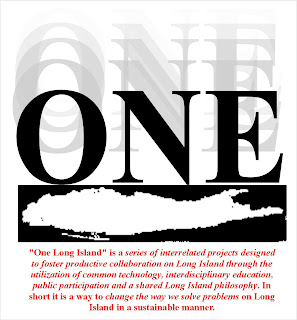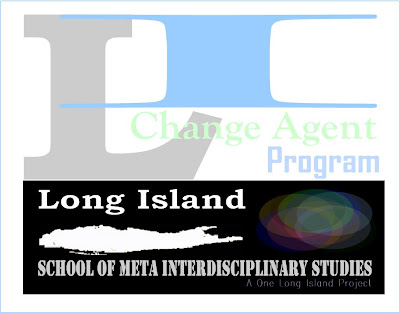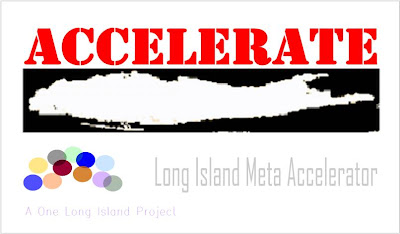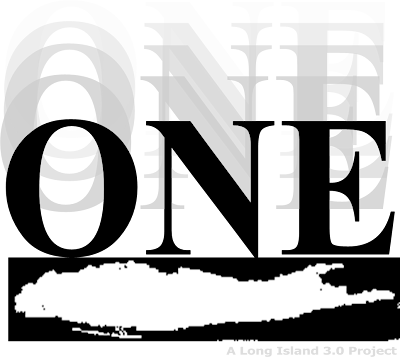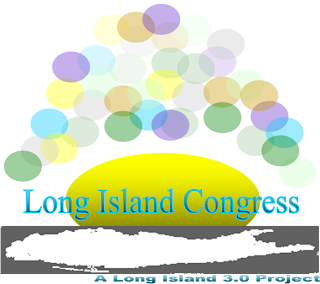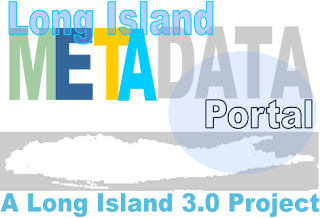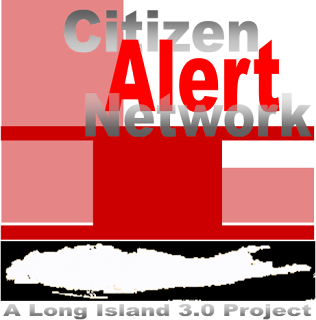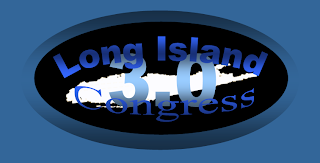
Friday, June 29, 2007
A different view of change

Thursday, June 28, 2007
A Paradigm Shift in Communications

Wednesday, June 27, 2007
Long Island Congress: A Virtual Think Tank
 Another way, at least in part, to view the Long Island Congress/Long Island 3.0 concept is as a Long Island "virtual think tank." A think tank that creates a dynamic environment for the accumulation, analysis and implementation of new ideas on a reasonable timetable and in an inclusive manner.
Another way, at least in part, to view the Long Island Congress/Long Island 3.0 concept is as a Long Island "virtual think tank." A think tank that creates a dynamic environment for the accumulation, analysis and implementation of new ideas on a reasonable timetable and in an inclusive manner.Tuesday, June 26, 2007
New Site for Long Island Citizen Journalists
"As you think, so you act. As you act, so you become."
As we have previously stated, the Long Island Congress and Long Island 3.0 concepts are as much about a new way of thinking as they are about hard and fast solutions.
Monday, June 25, 2007
Viral Organization Building?
 "One of the driving forces behind any successful discipline, institution, business, and any organizational structure for that matter, is the constant application of innovative ideas. Without innovation, things stagnate and can never realize their full potential. Advertising, as a creative social science, continually searches for innovative ways to capture audiences'€™ attention in order to communicate a particular message."
"One of the driving forces behind any successful discipline, institution, business, and any organizational structure for that matter, is the constant application of innovative ideas. Without innovation, things stagnate and can never realize their full potential. Advertising, as a creative social science, continually searches for innovative ways to capture audiences'€™ attention in order to communicate a particular message."Two more good signs for Long Island
Two on the right track
Friday, June 22, 2007
Taming the Feral Beast?
More good work ...
Good article with Ms. Lansdale. She seems to be on the right track in her particular area of expertise.
I'm sure that if her good ideas were pooled with others in different disciplines, the result would be a more comprehensive, coordinated, and ultimately more successful, approach to resolving public policy issues.
Thursday, June 21, 2007
Artifice as Reality? Part One.

"Reality is merely an illusion, albeit a very persistent one."
"What is emptiness? Emptiness (shunyata) is the reality of the existence of ourselves, and all the phenomena around us. According to the Buddhist point of view, seeking reality and seeking liberation amount to the same thing. The person who doesn't want to seek reality doesn't really want to seek liberation, and is just confused."
“The most dangerous thing is illusion.”
“It was more in our spirit to let things come to rights by the plain dictates of common sense than by the practice of any artifices.”
So much of what is done on Long Island seems to be done for "theatre" rather than for substantive change.
I don't think, however, this is done as some evil plot against the citizens of Long Island, although that would sell a lot of papers!
I think much of it is done out of a sense of frustration with the lack of communication and the "layers of complexity" surrounding almost every issue of public policy. Having many moving parts (organizations/individuals) doesn't necessarily make things complicated if there are permanent, common "bridges" of communication and a willingness to cooperate. This is the driving force behind the Long Island Congress and Long Island 3.0 concepts. Give people the means and the opportunity to cooperate and they will cooperate. Sort of like a "unified theory of regional cooperation." In future posts we'll explore what it takes to cooperate and to break down the "silos" and "fiefdoms" while still encouraging organizational autonomy and personal choice.
Some good lessons in leadership.
But while the expression of an authentic self is necessary for great leadership, the concept of authenticity is often misunderstood, not least by leaders themselves. They often assume that authenticity is an innate quality - that a person is either authentic or not. In fact, authenticity is a quality that others must attribute to you. No leader can look into a mirror and say, "I am authentic." A person cannot be authentic on his or her own. Authenticity is largely defined by what other people see in you and, as such, can to a great extent be controlled by you. If authenticity were purely an innate quality, there would be little you could do to manage it and, therefore, little you could do to make yourself more effective as a leader.
The ability to strike a balance, and to preserve one's authenticity in the process, is precisely what distinguishes great leaders from other executives. The challenge of great leadership is exactly that of managing one's authenticity, paradoxical though it sounds. (click for entire article)
Wednesday, June 20, 2007
Breaking Down Silos
 We've posted multiple times about the need to "speak a common language" and to create an a "dynamic interaction of organizations and information" as part of our Long Island 3.0/Long Island Congress leitmotif.
We've posted multiple times about the need to "speak a common language" and to create an a "dynamic interaction of organizations and information" as part of our Long Island 3.0/Long Island Congress leitmotif.The following (click for entire article) does a good job of explaining the process in a corporate setting which, of course, closely parallels what we hope to achieve on a larger scale here on Long Island. We may have more "moving parts" but the concepts are still valid.
"Using mapped folksonomy to break corporate silos
A problem in getting people in corporate silos to communicate is that they do not speak the same language even when they are talking about the same thing. Mapped folksonomy can bridge the language gap. The trick is to have people participating in the folksonomy label a good number of the same underlying things so you can see how the labels correlate across participants."
Meta-Editorialism: Part Four

Wikipedia, Smart Mob
What do we want?
 What do Long Islanders want?
What do Long Islanders want?Like most folks, I would imagine it is "maximum liberty with minimal governmental intrusion." This is not a plug for the libertarians out there or any other ideology, it is just a simple observation of how most folks live their lives.
The issue then remains what "liberty" and "governmental intrusion" mean to the individual. Is it an intrusion on my liberty not to have health care provided to me for the taxes I pay? Is it an intrusion on my liberty to pay taxes for health care I do not want? The liberty-intrusion formula is a complicated and ever shifting dynamic.
I would say that most Long Islanders want and expect safe neighborhoods, a clean environment, opportunity for good paying jobs, reasonable services at a fair tax rate, you know, all the perennial favorites.
I would also say that most people on Long Island are fair-minded, clear thinking individuals who care a great deal about their communities. The same can be said for the multitude of organizations that abound on Long Island.
Diversity and individuality must be part of the Long Island psyche. Does this mean Long Islanders won't cooperate? Not at all.
What has been missing from the "Long Island equation" is the ability of organizations and individuals to communicate clearly and rationally with one another. Thankfully we live in age where the communication revolution is in full swing. What is needed now is to take a step back, take a deep breath, assess where we are and devise a flexible plan to move us forward as a region while maintaining the individuality and diversity that still make Long Island a place many folks want to call home.
Hopefully our Long Island Congress and Long Island 3.0 concepts will play a small part in the "new" Long Island model.
I think we all know what we want.
Now it is time to get it done.
Tuesday, June 19, 2007
Some good news ...
We should have some good news about the creation of a Long Island Congress and a plan to implement some Long Island 3.0 concepts pretty soon.
Thanks to all who have agreed to participate.
Connect the Dots Redux
How does it connect to this or any of the dozens of other good ideas out there?
Long Island 3.0/Long Island Congress will give us the means and opportunity to cooperate.
What it won't give us is the will.
Maybe Blue Gene can help?
Long Island Must Help Itself.
Granted this is tourism, an important part of the Long Island economy, but only part of the economy nevertheless.
Long Island can no longer wait on the "good graces of others" to develop itself into a regional powerhouse. Yes, New York State must help all regions, especially the economically depressed upstate region, but we should be able to do more than one thing at a time and do it well, shouldn't we?
Long Island must make itself a priority which contributes to the state economy, but is not dependent on NYS government to move forward on its initiatives. Yes, Long Island should get its "fair share" of state resources, but we must deal from a position of strength.
This is why I believe the time has come for a Long Island Congress and related Long Island 3.0 ideas. Maybe the State of Long Island is a bit extreme (today anyway!), but a coordinated and powerful Long Island is not.
February 1950
Congressman James Delaney of Astoria raised eyebrows in February 1950 when he announced, somewhat tongue in cheek, that he wanted to make the State of Long Island. A member of the House Rules Committee investigating admitting Hawaii and Alaska as states, he claimed that Long Island would make a much better case for statehood, and “if you throw in New York City, there is no comparison.” He continued, “Alaska, with 90,000, has 1/4 the members of my district.” The proposed state, with 26 members in Congress, would have about the same sized congressional delegation as California or Illinois. Jamaica would be the proposed capital of the state of 9 million.
It is time to become self sufficient.
Monday, June 18, 2007
If there's an e-Trikala, why not a Long Island 3.0?
While the Long Island 3.0, New York 3.0 and Long Island Congress concepts take in to account more than government, the above article does provide guidance as to some of what is possible.
Sunday, June 17, 2007
Use a Scalpel, Not a Sledgehammer
Interesting history of special districts above (click for entire article) and well worth reading. Good information here as well.
I had the pleasure of watching the Glenwood Fire Company's 100th Anniversary Parade this past Saturday in my hometown of Glen Head. Many of the local fire departments were present.
Although I know many of the volunteers from my days as a Town Councilman (I had the pleasure of creating the first or one of the first Fire Advisory Boards to foster cooperation between the town and the fire service) and from growing up in the area, it still gives me a sense of pride in community to see the level of professionalism and sacrifice these folks make on our behalf. There was a large crowd present and they too gave the volunteers a great response.
There is just something special about Long Island and the way it works that we need to be cognisant of before making wholesale changes. It is almost like a great intricate clock filled with moving parts that work in unison to create the heartbeat of our island. Whether it is the fire service or the environment or any of the dozens of other community causes and organizations on our Island, we all share a sense of pride in our communities.
Why do people still want to live on Long Island and continue to move here? I believe most folks know the good far outweighs the bad and they enjoy the sense of a "smaller community" that they have more control over while still having the opportunities that exist within a larger metropolitan area.
Long Island is a unique mix. We can look to other areas of the country and the world for ideas on how we can make Long Island better, but trying to "force" Long Island to become some other region, I think, is ultimately a fool's errand. We have to take what we have, understand what we are and make it work better. That requires a deeper level of analysis and commitment than garden variety comparisons and lists of complaints.
The Community Congress (and now Virtual Community Congress and Long Island Congress) concepts are ideas about how to harness this positive energy for the common good. I also had the pleasure of starting one of the first Marine Education Day educational programs here on Long Island which has now exposed tens of thousands of school children to our environment and how to protect it. This too was part of the Community Congress concept.
I admit to at least a little bias when it comes to our fire companies and volunteers and the the pride residents of Long Island take in their individual communities on all levels. When I was a young man I used to march in bands all over Long Island playing my trumpet and countless Sousa marches in hundreds of community celebrations. You really get a sense of how Long Island ticks at the grass roots level in these unguarded celebratory moments when a community comes together to celebrate itself and its accomplishments.
Do we need to change on Long Island to prepare for a better future? Yes.
Do we also need to preserve the elements that make Long Island a unique and good place to live? Yes.
Can we do both? Absolutely.
All the Long Island 3.0/ Long Island Congress ideas are geared towards a cooperative, productive Long Island. We will always have many "moving parts" on our island, even if the parts change from time to time. If we do not have a methodology to address change in a dynamic way, we will always be "behind the curve" in our decision making capabilities.
Let's be smart about change. Think before we act.
Use a scalpel, not a sledgehammer
Thursday, June 14, 2007
Long Island Congress ... Lux Perpetua.
 The creation of a Long Island Congress will create a vehicle for the unbiased, clear thinking analysis all Long Islanders require to make rational decisions.
The creation of a Long Island Congress will create a vehicle for the unbiased, clear thinking analysis all Long Islanders require to make rational decisions.This "public policy lux perpetua (ceaseless light)" will allow decisions to be made openly and without distortion.
It has been my experience as both a public official and private citizen that, while various advocacy organizations and individuals will have strong opinions and use "tough" tactics to push their cause, most, with some exceptions know how to cooperate and compromise.
The one thing we can not do is allow the public or organizations to think that information is being withheld or otherwise skewed to allow for a predetermined outcome. Let unreasonable people be unreasonable. Eventually, they only harm themselves and become irrelevant.
Obviously we live on an island. We have limited resources as would any islander. We must work smarter and in a more coordinated manner for all the reasons we've discussed in previous posts.
No one is naive enough to think a major change like this will be without a few bumps in the road. It has been my experience that most public officials want to cooperate with one another to make their communities better. Given the opportunity they, along with the rest of us, can achieve great things for Long Island.
For example this is the type of big idea we need to look at with a serious and unbiased eye. There are many good ideas like this out there from many different sources just waiting to be examined, analyzed and implemented.
We must think of Long Island not as a destination to somewhere else or a temporary state of affairs. Instead we must commit fully to a coordinated, strong Long Island able to hold its own with any other region; nationally or internationally.
A Long Island Congress (containing Long Island 3.0 concepts) with its "public policy lux perpetua "of objectivity and reason can be a major assistance in shaping a brighter Long Island future.
Wednesday, June 13, 2007
More thoughts on a Long Island Congress.

It is, but it will take a change in how we approach public policy problem solving.
Instead of viewing ourselves as part of one organization or another, concerned with only one issue or another; we must instead think as a "pan-Long Island-ist" practicing "pan-Long Island-ism" (general term for the various movements or approaches on Long Island that have as their common goal the unity of Long Island and the fostering of non-confrontational, cooperative interaction between all Long Island organizations).
That is to say, how do all Long Island issues connect in the broadest sense and how do we create an environment conducive to the long term health of all Long Islanders?
First issue. Please leave your ego and ambition at the door. The Long Island Congress can not be viewed as a "launching pad" for political office or as a forum to "dominate" some sector of the debate.
Second issue. Have some humility. No one has all the answers and those who are not naturally assertive may in fact have the missing piece to the puzzle. The Long Island Congress must be inclusive.
Third issue. Learn to compromise and think of ways to build bridges between your position and others. Many times we think we have the whole solution when in fact we only have a part of it.
Fourth issue. Long Island must be unified in most issues to survive any adverse economic downturn, loss of political power or other "global" crises. If we don' t have a coordinated approach to solving Long Island's issues, we may be easily "divided and conquered" by interests outside of Long Island. For Long Island to remain "relevant" not only in New York State affairs, but as a region that has relevance in the wider world at large, we must be united.
Fifth issue. We must allow for our unique differences while cooperating as a region. Let's start simple and work up to the bigger issues. Success breeds success. Here is an example of some folks starting to think in the right direction, although it is not clear if there must be a major consolidation of these groups. Consolidation follows cooperation; it is not a means to an end in and of itself.
These are just some initial thoughts. More to follow.
Tuesday, June 12, 2007
How about a Long Island Congress?

We've talked previously about a "Community Congress" or a "Virtual Community Congress" and while there have been attempts to bring organizations and individuals together on Long Island for specific issues, I'm unaware of any attempt to have an ongoing dialogue amongst government leaders and relevant organizations and individuals on, let's say, a quarterly basis to discuss all of the major issues of the day.
Furthermore, this "Long Island Congress" can also be virtual (to maintain the dynamic interaction we've previously spoken about) and should not cost much to maintain. This is NOT a new bureaucracy. This is a method and a forum to bring the best and brightest together on Long Island in a non-confrontational, cooperative manner to find solutions to the issues that affect Long Islanders. Most of the Long Island 3.0 ideas lend themselves perfectly to this type of interaction.
Over the next few posts we'll attempt to create a specific framework that would encourage the Long Island Congress to be created and to be successful.
Sunday, June 10, 2007
What do you think?
I suspect that what they will find at the end of the day is what they already suspect or know the issues to be; taxes, housing, transportation, energy, real estate development and perhaps open space, job development and a number of other quality of life issues.
Long Island is, right now, a pretty nice place to live for most folks and Newsday and others properly point out that we must start planning now so that it remains in good shape.
Of course Newsday and LI Business are also reacting to the new way people get their information and are, as they should, attempting to stay current. That aside, what they are doing does help create part of the open dynamic we've are striving for in our Long Island 3.0 and New York 3.0 concepts.
Identifying the issues is probably the easy part. Solving them is not.
To solve the issues we need a new approach to public policy. Organizations, of all stripes, must think outside their "silos" and find real approaches to cooperate with one another. We've suggested a number here on LIIF, but as we've also said, Long Island is home to some of the smartest folks on the planet. There are many good, workable ideas out there just waiting for leadership.
If you were an engineer and had a "design flaw" in your project, would you keep trying to get the design to work or would you change your design? Using the same methods for approaching Long Island issues is analogous to a "design flaw." No matter how hard you try the results will never come out the way you want them to be.
Leadership may be political, the media or from a host of other sources. Leadership requires sacrifice not only on those the "leaders" are attempting to motivate, but on the "leaders" as well.
The idea of sacrifice for the common good is essential for long term positive change. It is what got our parents and grandparents through World War II. Big changes require big sacrifice.
People must "buy in " to the change and trust that the information they get is accurate and fairly presented. We've attempted in some past posts to begin to construct a "decision model" for Long Island which is essential in entering a new phase of Long Island's future.
Can we put aside partisan and pre-established opinions and methods of thinking to forge a new Long Island? Time will tell.
I prefer to think we're up to the challenge. How about you?
What do you think?
Friday, June 8, 2007
Another Piece of the Long Island Puzzle

"Economic growth, university-style, on Long Island
By Robert A. Scott
Friday, June 8, 2007 (LI Business News)
Imagine a community chamber of commerce that decided to start a strategic planning process for economic development, including the following principles and priorities.
First, they want to recruit an enterprise that would produce a product or service of which everyone could be proud. Second, they want an enterprise whose employees are highly educated and willing to be active in community organizations. Third, they want an enterprise that is respectful of the environment. Fourth, they want an enterprise willing to partner with schools, the civic community and businesses. Fifth, they want an enterprise that would have a significant and positive impact on the local economy through taxes paid and both operating and capital expendures.
On Long Island, that enterprise is higher education. There are 19 colleges and universities here with combined annual budgets totaling over $3.2 billion – that easily translates into a $4 billion economic impact, and this does not count the effects of more than $1 billion in capital investments committed for the next five years.
Nor does it count FICA, federal and state income taxes and other taxes collected. And when one adds in the restaurant, hotel and other expenditures of those who visit campuses during the year (for homecoming, reunions, cultural events, graduations and sports events), the economic impact grows even larger – and we haven’t even mentioned the expenditures of nearly 175,000 students and 38,000 employees.
Universities are teachers, models and partners in economic and community development. We use our intellectual, cultural and capital assets to prepare professionals, managers and artists; to contribute to the quality of life that attracts and sustains businesses; and to create jobs and wealth. This is economic development, university-style: the community developer’s dream partner."
Robert A. Scott is president of Adelphi University in Garden City.
Some additional interesting thoughts:
Newsday 6/8/07 Letters to the Editor
Use Avis site for affordable homesIt is common knowledge through the work of the Long Island Association and the Rauch Foundation's Long Island Index that Nassau and Suffolk counties lack adequate supplies of affordable housing for young professionals and service workers. As a consequence, businesses, schools and colleges find it difficult to recruit those with critical skills. The challenge for the business sector is so severe that we now refer to the "Top 75" public companies, not the "Top 100."Too much of new housing is for those 55 and older with no school-age children. Rental apartments at affordable rates are hard to find.County, state and federal properties no longer used for their public purpose should be zoned, in whole or in part, for multiple-dwelling workforce, or "starter," housing.Now on Old Country Road at the site of the old Avis property in Westbury, we have an opportunity to build housing for young professionals and others who could fill critical job needs and become the consumers and taxpayers Nassau County needs.With some imagination, special zoning and Hempstead support, a new housing development could help revitalize an area that could easily become blighted if attention is not given to our highest priorities.Surely, this must be of interest to the county executive, the Town of Hempstead and Simon Properties, owners of nearby Roosevelt Field Mall.
Robert A. Scott Editor's note: The writer is president of Adelphi University.Garden City
Thursday, June 7, 2007
Static Thinking versus Dynamic Thinking
As we explored in 1993 and more recently here and here among many other posts, the key to change is cooperation and "dynamic interaction."
Change is a continuous process and public officials as well as others need the tools and the correct approach to problem solving to create good, comprehensive public policy.
Reports and commissions are helpful. But if the information is not dynamic, it still may have some result, but it will never be a long term building block for sustainable growth and change.
The LI Regional Planning Board has an interesting proposal here on affordable housing.
Unfortunately we do not yet have a comprehensive method for analyzing all these potentially good ideas as a unified concept. Long Island 3.0 is one possible solution.
Wednesday, June 6, 2007
New Thinking. Not New Bureaucracy.
Long Island 3.0 (and/or New York 3.0) is as much about how we approach a set of issues as how we ultimately resolve these issues and the methods we use to do so.
As we have stated previously, we need to be open to all relevant new ideas, no matter what the source, and create an environment where these ideas are fully vetted and incorporated into the decision-making processes and organization designs.
Tuesday, June 5, 2007
New York State XML Update? New York 3.0?
It looks a little restrictive as to what's allowable if, in fact, the RFP process was ever completed.
It would probably be in the state's best interests to take a broader view toward xml standards and open data standards in general for all New York State agencies and authorities and all New York State political subdivisions.
Just as we're proposing a Long Island 3.0 approach to public policy solutions, perhaps New York should take a similar approach as well.
Open architecture, multiple platforms, multiple API. The more businesses we can interest in developing products for New York, the better it is for the New York economy.
The state (and/or Long Island) should lead the way in promoting creative thinking and innovative products and should, in essence, be a laboratory for their implementation.
Monday, June 4, 2007
Connect the dots ...

Excellent project by Congressman Israel.
Will his project work in a coordinated way with this excellent project from Senator Skelos?
And with these as well?
The Long Island 3.0 project we are proposing could be the "glue" that coordinates these and other projects.
Saturday, June 2, 2007
More good ideas ...
All we need to do is add this to the selectable XML Public Alert Feed lists we talked about earlier and this project will have a simple resolution.
When we get the details regarding Deputy Secretary for Homeland Security Mike Balboni's NYS alert project we will attempt to integrate our ideas with his if necessary.
Congressman Bishop's idea and Senator Skelos' Campus Alert idea really all should be interconnected with Mr. Balboni's idea (or vice versa) and other ideas that may be feasible.
As we've said previously, all alert projects (and general public information as well) must, at a minimum, be based on an open architecture with multiple API and available on multiple platforms.
Friday, June 1, 2007
XML for the New York State Unified Court System?
Utah State Courts
West Virginia Supreme Court
The Philadelphia Courts
Maryland Judiciary
St. Louis Circuit Court
New Mexico District Court
xmlLegal
Oasis
XML and related technology should speed up the transmission of information in the NYS Courts just as it has in other disciplines.
It would also position the courts for greater participation in Web 2.0 and emerging Web 3.0 technologies and allow for greater interaction between all parties in all aspects of court administration.
These are the only New York State RSS/XML feeds I've been able to locate so far for all agencies including what it says is the Unified Court System but actually appears to be the Justice Court feed. Please let me know if you locate any other feeds. Also NYSTAR has a feed.
All of this, of course, needs to be standardized in a simple, flexible manner and spread to all state agencies, authorities etc. and to all political subdivisions of New York State.

